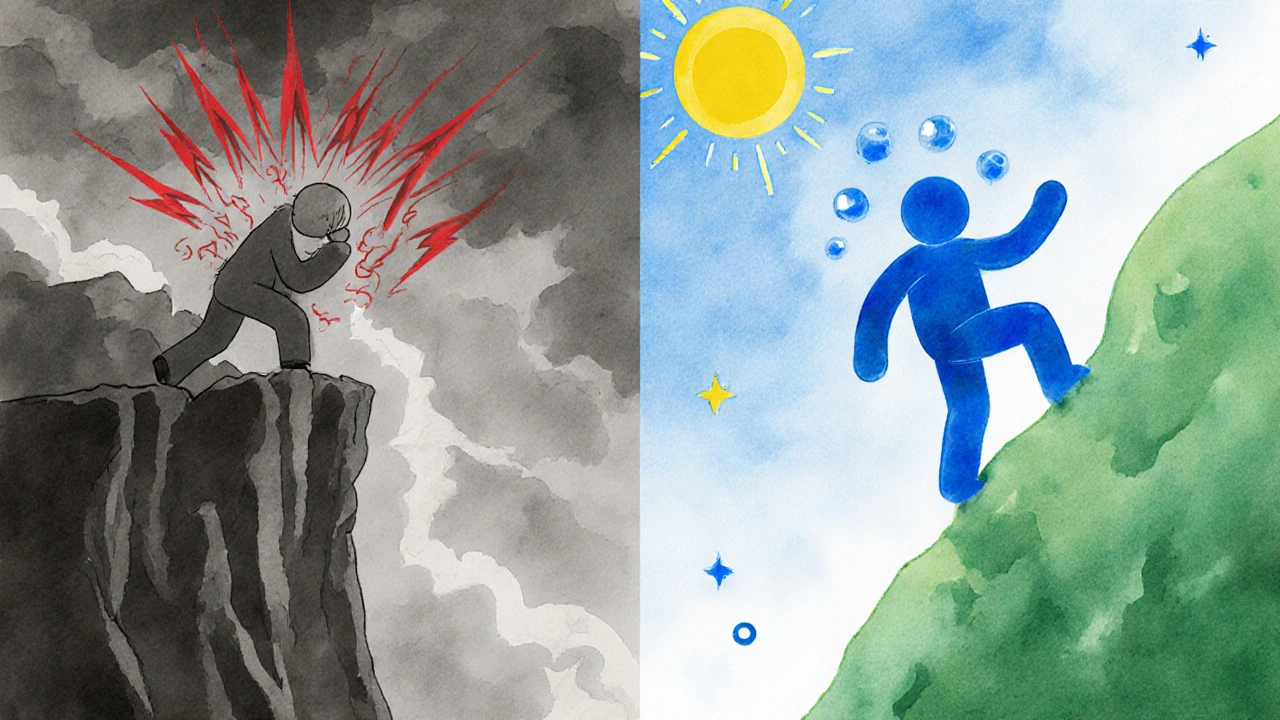Mindset & Weakness Transformation Calculator
Your transformation insights will appear here after clicking the button above.
| Aspect | Fixed Mindset | Growth Mindset |
|---|---|---|
| Belief about Ability | Static and unchangeable | Developable through effort |
| Response to Failure | Defensive, avoids challenges | Curious, seeks feedback |
| Motivation Source | External validation | Internal mastery |
| Learning Strategy | Repetition of known tasks | Deliberate practice on weak areas |
| Impact on Weakness | Stagnates or widens gap | Narrows gap, builds competence |
Ever wonder why some people bounce back from a shortcoming while others stay stuck? The secret isn’t the size of the weakness-it’s the mindset they bring to it. When you flip the mental lens, a flaw becomes a launch pad for growth.
Key Takeaways
- Weakness is a data point, not a destiny.
- A fixed mindset keeps a weakness static; a growth mindset makes it fluid.
- Self‑efficacy, resilience, and emotional intelligence are the muscles that turn a flaw into fuel.
- Practical habits-reflection, incremental practice, and feedback loops-re‑wire the brain.
- Common traps include over‑identifying with a weakness and ignoring strengths.
What Is a Weakness?
Weakness is a personal limitation or area where performance falls short of desired standards. Recognizing a weakness means acknowledging a gap between current abilities and goals. It’s not a permanent scar; it’s a signal that your skill set can be expanded.
Understanding Mindset
Mindset is the collection of beliefs and attitudes that shape how you interpret experiences, challenges, and your own capabilities. Psychologist Carol Dweck popularized the terms “fixed mindset” and “growth mindset,” showing that the stories we tell ourselves drive real‑world outcomes.

How Mindset Shapes the Perception of Weakness
When you view a weakness through a fixed lens, the brain treats it as a threat. Stress hormones spike, motivation dips, and you’re likely to avoid the task altogether. In contrast, a growth lens treats the same data point as a learning opportunity. Dopamine rewards the effort of trying, making the brain eager to close the gap.
Research from Stanford’s Center for Mind and Brain (2023) found that participants with a growth mindset improved performance on a previously weak skill by 27% after a month of deliberate practice, while those with a fixed mindset showed no measurable gain.
Fixed Mindset vs. Growth Mindset
| Aspect | Fixed Mindset | Growth Mindset |
|---|---|---|
| Belief about Ability | Static and unchangeable | Developable through effort |
| Response to Failure | Defensive, avoids challenges | Curious, seeks feedback |
| Motivation Source | External validation | Internal mastery |
| Learning Strategy | Repetition of known tasks | Deliberate practice on weak areas |
| Impact on Weakness | Stagnates or widens gap | Narrows gap, builds competence |
Building a Growth Mindset to Leverage Weakness
Shifting from fixed to growth isn’t a one‑off switch; it’s a series of habits that gradually rewire neural pathways.
- Identify the data point. Write down the specific skill or behavior that feels weak.
- Reframe the narrative. Turn “I can’t do this” into “I’m learning how to do this.”
- Set micro‑goals. Break the weakness into bite‑size tasks-5‑minute daily drills, for example.
- Seek immediate feedback. Use a mentor, peer, or video recording to spot progress.
- Track progress. A simple spreadsheet charting success rates over weeks provides visual proof of growth.
When these steps become routine, you’ll notice an increase in Self‑efficacy is the belief in your own ability to execute actions required for desired outcomes. Higher self‑efficacy fuels persistence, which in turn speeds up skill acquisition.

Related Concepts That Reinforce the Mindset‑Weakness Link
Resilience is the capacity to recover quickly from difficulties, turning setbacks into stepping stones. By practicing resilience, you protect your motivation when progress stalls.
Emotional intelligence is the ability to recognize, understand, and manage your own emotions as well as those of others. High emotional intelligence helps you stay calm during the discomfort of confronting a weakness.
Cognitive bias refers to systematic patterns of deviation from rational judgment. The "confirmation bias" often makes us cling to a fixed mindset by highlighting only evidence that supports our self‑imposed limits. Becoming aware of these biases opens the door to more objective self‑assessment.
Common Pitfalls and How to Avoid Them
- Over‑identifying with the weakness. Treat the flaw as a label rather than a data point. Use neutral language like “area for improvement.”
- Skipping reflection. Without regular review, you can’t see incremental gains.
- Relying solely on willpower. Willpower fatigues; pair it with structured routines and external accountability.
- Neglecting strengths. A balanced view keeps motivation high; leverage strengths to support weak areas.
Next Steps: Personal Action Plan
Grab a notebook and answer these three prompts:
- What is one specific weakness you want to improve this month?
- Which growth‑mindset habit will you start tomorrow (e.g., 10‑minute deliberate practice, feedback request)?
- How will you measure success (e.g., speed, accuracy, confidence rating)?
Review your answers every Sunday. Adjust the micro‑goals based on what the data shows, and keep the narrative focused on learning.
Frequently Asked Questions
Can a weakness ever become a strength?
Yes. When you apply a growth mindset, deliberate practice, and feedback, the skill gap shrinks. Over time, the former weakness can surpass previous strengths, especially if you leverage related abilities.
Is it normal to feel demotivated when working on a weakness?
Absolutely. Confronting a gap triggers discomfort. The key is to recognize the feeling as a sign of growth, not a reason to quit. Pair the work with small wins to reset motivation.
How long does it take to see improvement?
Research shows noticeable gains after 4‑6 weeks of consistent, focused practice. However, the timeline varies by complexity of the skill and the intensity of effort.
Do I need a coach or can I do this alone?
Both work. A coach accelerates feedback loops, but self‑directed learning works if you set clear metrics, capture data, and stay accountable.
What role does emotional intelligence play?
Emotional intelligence helps you manage frustration, stay calm under pressure, and empathize with mentors who give feedback. Higher EI correlates with faster skill acquisition.


Ajay D.j
October 7, 2025 AT 18:17Mindset really does shape how we tackle our weak spots.
Dion Campbell
October 10, 2025 AT 01:50While the article is aesthetically pleasing, its substantive depth leaves much to be desired. The reliance on generic tables and buzzwords feels like a veneer over a shallow analysis. One would expect a more rigorous engagement with the underlying neuroscience, rather than a spreadsheet of platitudes. In short, the piece reads like a self‑help brochure with a glossy UI.
Burl Henderson
October 12, 2025 AT 09:23The discourse delineates the epistemological shift from a deterministic mindset paradigm to a constructivist growth trajectory. By operationalizing weakness as a quantifiable variance, the author leverages a metric‑driven feedback loop. This aligns with the iterative agile methodology, wherein micro‑sprints target competency gaps. Moreover, the integration of dopaminergic reinforcement mechanisms underscores a neuro‑behavioral scaffold.
Leigh Ann Jones
October 14, 2025 AT 16:57Reading through the extensive articulation of mindset theory feels like embarking on a marathon of abstract concepts. The author meticulously enumerates each psychological construct, from self‑efficacy to cognitive bias, before weaving them into a cohesive narrative. Each bullet point is expanded into a paragraph that references empirical studies, which can be both enlightening and overwhelming. The repeated emphasis on deliberate practice serves as the backbone of the argument, reinforcing the central thesis that weakness is malleable. Yet, the sheer volume of information occasionally obscures the practical steps a reader might take. The inclusion of data tables, while informative, adds a layer of visual fatigue that competes with the textual content. Nevertheless, the section on emotional intelligence provides a refreshing pivot toward affective considerations. The author's voice oscillates between scholarly exposition and motivational pep talk, creating a tonal inconsistency that may alienate some audiences. The discussion of neurochemical responses, particularly dopamine and cortisol, injects a physiological dimension that enriches the psychological perspective. The narrative also cautions against common pitfalls such as over‑identification with one’s shortcomings, a point that resonates deeply. Throughout, the author interlaces actionable micro‑goals, encouraging readers to adopt a bite‑size approach to skill acquisition. The roadmap culminates in a personal action plan that invites reflection and iterative adjustment. While the length and depth are commendable, a concise executive summary would have benefitted time‑pressed readers. Overall, the piece stands as a comprehensive guide, albeit one that demands sustained attention and patience. In the end, the integration of mindset theory with practical exercises underscores the transformative potential of a growth orientation. Future revisions might consider segmenting the content into more digestible modules to enhance accessibility.
Sarah Hoppes
October 17, 2025 AT 00:30They hide the real data behind flashy charts
Robert Brown
October 19, 2025 AT 08:03Your growth tips are nonsense, stick to facts.
Erin Smith
October 21, 2025 AT 15:37Hey, I get where you're coming from, but you can still see progress if you break the process into tiny daily wins and celebrate each one.
David Ross
October 23, 2025 AT 23:10I appreciate the thoroughness of this post and think the key takeaway is that mindset is a skill we can train, just like any other muscle.
Lynnett Winget
October 26, 2025 AT 05:43Exactly! Think of your brain as a garden-water the seeds of curiosity, prune the weeds of self‑doubt, and watch the blossoms of competence explode in color.
Angelo Truglio
October 28, 2025 AT 13:17Oh my god!!! This masterpiece blew my mind!!! The way you turned a boring weakness into a glorious quest for greatness is pure theatrical gold!!! 😲
Angel Gallegos
October 30, 2025 AT 20:50While your enthusiasm is palpable, the sentence “Your growth tips are nonsense, stick to facts.” should be punctuated as “Your growth tips are nonsense; stick to facts.” for proper clause separation.
Sarah Aderholdt
November 2, 2025 AT 04:23Contemplating the fluidity of weakness invites us to consider that imperfection is not a flaw but a canvas upon which the mind paints its evolution.
Phoebe Chico
November 4, 2025 AT 11:57Indeed, the journey from limitation to triumph mirrors the proud saga of our nation's relentless pursuit of excellence, a story painted in bold, vibrant strokes of ambition.
Larry Douglas
November 6, 2025 AT 19:30Empirical literature indicates that a growth mindset correlates with measurable improvements in task performance, specifically a 27 % gain after four weeks of structured deliberate practice, as documented in the 2023 Stanford study.
Michael Stevens
November 9, 2025 AT 03:03I totally feel you on the struggle; just remember that every tiny step you take adds up, and having a buddy to share feedback can make the climb feel a lot less steep.
Ann Campanella
November 11, 2025 AT 10:37Honestly, this whole thing feels overhyped.
Desiree Tan
November 13, 2025 AT 18:10Cut the noise-take the action plan, set those micro‑goals, and crush them. No excuses.
Andrea Dunn
November 16, 2025 AT 01:43All these so‑called “research findings” are just another layer of control hidden behind academic jargon.